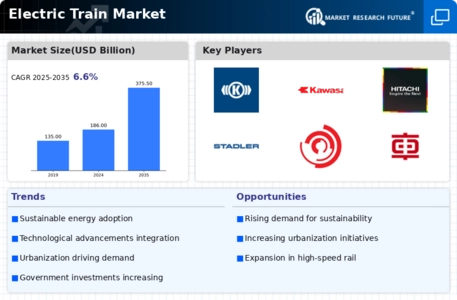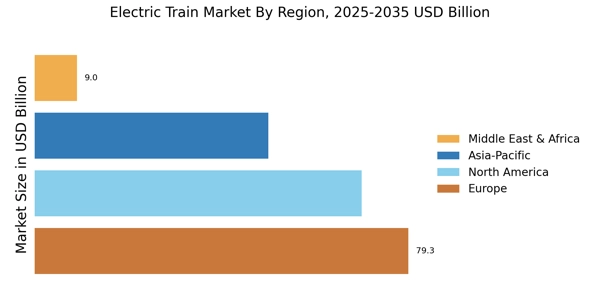Government Support and Investment
The Electric Train Market benefits significantly from government support and investment. Many governments are increasingly recognizing the importance of sustainable transportation solutions, leading to substantial funding for electric train projects. For instance, recent data indicates that investments in electric rail infrastructure have surged, with some countries allocating billions to enhance their rail networks. This financial backing not only facilitates the development of new electric train systems but also aids in upgrading existing ones. Furthermore, government incentives for electric train manufacturers and operators encourage innovation and competition within the Electric Train Market. As a result, the combination of public funding and policy support is likely to drive growth and expansion in this sector.
Urbanization and Population Growth
Urbanization and population growth are significant drivers of the Electric Train Market. As urban areas expand and populations increase, the demand for efficient and sustainable transportation solutions intensifies. Electric trains offer a practical response to the challenges posed by urban congestion and pollution. Recent statistics indicate that cities with robust electric train networks experience reduced traffic congestion and improved air quality. This trend is prompting city planners and governments to invest in electric rail systems as a means to accommodate growing populations. Consequently, the increasing urbanization and the need for sustainable transit options are expected to bolster the Electric Train Market, as more regions seek to implement electric train solutions.
Environmental Regulations and Standards
The Electric Train Market is influenced by stringent environmental regulations and standards aimed at reducing carbon emissions. Governments worldwide are implementing policies that mandate lower emissions from transportation systems, which positions electric trains as a viable alternative to traditional diesel-powered trains. For example, recent regulations have set ambitious targets for reducing greenhouse gas emissions, prompting rail operators to transition to electric solutions. This shift not only aligns with global sustainability goals but also enhances the appeal of electric trains among environmentally conscious consumers. Consequently, the increasing pressure to comply with environmental standards is expected to propel the growth of the Electric Train Market, as more operators seek to modernize their fleets.
Rising Fuel Prices and Economic Factors
Rising fuel prices and various economic factors are influencing the Electric Train Market. As the cost of fossil fuels continues to fluctuate, rail operators are increasingly looking for cost-effective alternatives. Electric trains, which typically have lower operational costs compared to diesel trains, present a financially attractive option. Market analysis indicates that the total cost of ownership for electric trains is often lower, especially when considering maintenance and fuel savings. Additionally, economic factors such as government subsidies and incentives for electric transportation further enhance the appeal of electric trains. As a result, the combination of rising fuel prices and favorable economic conditions is likely to drive the growth of the Electric Train Market, encouraging more operators to transition to electric solutions.
Technological Innovations in Electric Train Systems
Technological innovations play a crucial role in shaping the Electric Train Market. Advances in battery technology, energy efficiency, and automation are transforming the capabilities of electric trains. For instance, the development of high-capacity batteries has extended the range and operational efficiency of electric trains, making them more competitive with traditional rail systems. Additionally, the integration of smart technologies, such as real-time monitoring and predictive maintenance, enhances the reliability and performance of electric trains. Market data suggests that the adoption of these technologies is on the rise, with many manufacturers investing heavily in research and development. As a result, the continuous evolution of technology is likely to drive the Electric Train Market forward, attracting new investments and customers.


















Leave a Comment